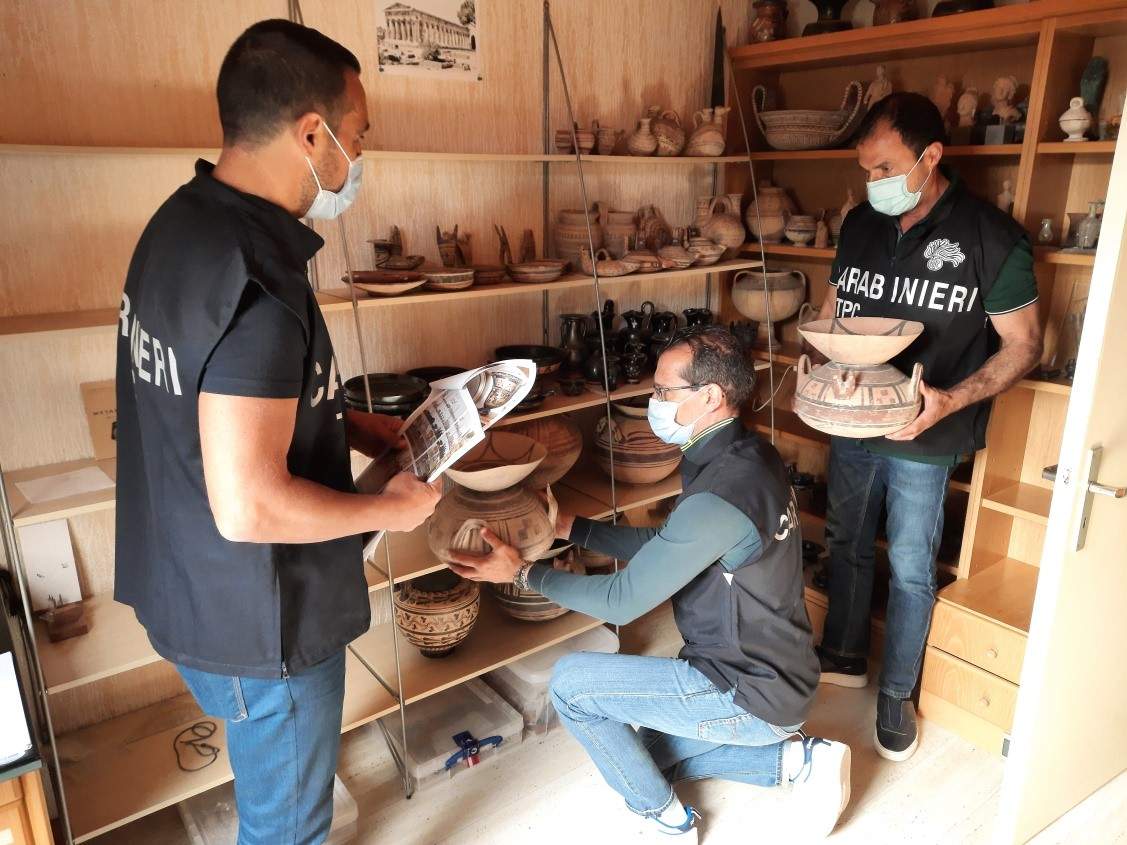Important recovery by the Carabinieri of the Nucleo per la Tutela del Patrimonio Culturale in Bari who bring back from Belgium to Italy an archaeological treasure composed of 782 pieces stolen from clandestine excavations in Puglia: this is the largest recovery ever for Puglia in terms of number of pieces, and one of the most significant nationwide. The result was made possible thanks to the work of the military of the Arma coordinated by the Public Prosecutor’s Office of Foggia, and with the contribution of Eurojust, the European Union’s agency for criminal judicial cooperation.
The investigation began in 2017 after the Restoration Laboratory of the Soprintendenza Archeologia, Belle Arti e Paesaggio of the provinces of Barletta-Andria-Trani and Foggia sent the Carabinieri a report that led to the identification of a Daunia stele in the collection of a wealthy Belgian collector. The stele was typical of the archaeological area of Salapia, near Cerignola (Foggia), and had been recognized as coming from this site because of its decorative features. It was also a well-known work because it was published in the catalog of the exhibition L’Art des Peuples Italiques 3000 à 300 avant J.-C. (“The Art of the Italic Peoples from 3000 to 300 B.C.”) held from Nov. 6, 1993 to Feb. 13, 1994 at the Musée Rath in Geneva, Switzerland. Not only that, the stele had also been published in the catalog of another exhibition, held from March 1 to April 30, 1994 at the Mona-Bismarck Foundation Museum in Paris. The find, however, appeared incomplete in the central part: in fact, a decorative inscription corresponding to a fragment kept at the Archaeological Museum of Trinitapoli (province of Barletta-Andria-Trani) was missing, which, according to the intuition of a Restoration Laboratory official, completed the design of the lower margin of the shield and the upper part of the warrior on horseback, depicted in the ancient artifact.
From this finding, investigations in Switzerland were initiated through the Interpol service, which led to the identification of the owner of the artifact: the elements that investigators subsequently gathered, regarding the potential possession of other ceramic artifacts stolen from grave goods of tombs clandestinely excavated on Apulian territory, led the Carabinieri of the Nucleo Tutela Patrimonio Culturale of Bari to make a request to the Public Prosecutor’s Office of Foggia to issue a European Investigation Order (EIO) for the search and seizure of additional archaeological goods of Italian provenance potentially in the possession of the collector in Belgium. It thus emerged that the man had also attended a number of conferences on Magna Graecia as part of an annual review held in Taranto, attended by numerous collectors and scholars. In December 2018, the Foggia Public Prosecutor’s Office issued the EIO, which was later executed by the Belgian Federal Police with the participation of military personnel from the Bari TPC Unit, who located the Daunian stele in the collector’s home in a municipality in the province of Antwerp, and verified that the fragment kept at the Trinitapoli Museum was perfectly superimposable and completed the missing part of the stele’s design.
During the search of the collector’s home, a veritable treasure trove of archaeological artifacts was recovered, consisting of some 782 Apulian figurative pottery artifacts and other Daunian stelae, all illegally exported from Italy, which were then seized in Belgium. The ensuing request by the Italian Judicial Authority to have the seizure maintained and the goods transferred to Italy for scientific and technical examinations by specialized personnel was granted by the foreign Judicial Authority, becoming the subject of repeated appeals by the Belgian suspect (all of which were rejected over time).
The technical examination carried out in Belgium by the Italian archaeological consultant revealed the authenticity and cultural-historical value of the 782 archaeological artifacts found in the suspect’s possession, all of which came from Puglia. The pieces include a large number of Apulian red-figure vases, amphorae, black-painted pottery, indigenous and Attic ceramics with geometric and figured painted decoration, figured limestone stelae from ancient Daunia, as well as a large number of “tanagrine” figured terracottas, fictile heads, winged figurines, and more. These are national assets dated between the 6th and 3rd centuries B.C., protected under the Cultural Heritage and Landscape Code, with a commercial value of about 11 million euros, looted and dismembered from their original contexts, now repatriated.
 |
| Recovered treasure of 782 archaeological finds in Belgium: it is the largest recovery for Puglia |
Warning: the translation into English of the original Italian article was created using automatic tools. We undertake to review all articles, but we do not guarantee the total absence of inaccuracies in the translation due to the program. You can find the original by clicking on the ITA button. If you find any mistake,please contact us.